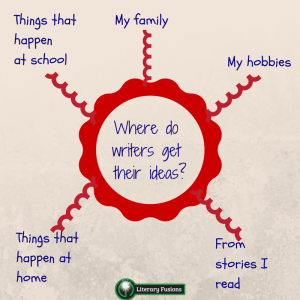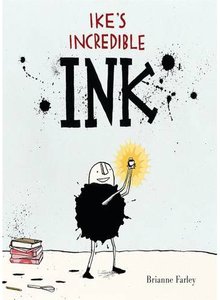Simple! There’s an ink blot on the cover. That same ink blot apparently has a name and it’s IKE! FABULOSITY!! I assumed that the book would be perfect for Writers’ Workshop and I was correct…
Why I Finished It:
…but I had no idea just how perfect it would be! I loved how this little ink blot was so real. In fact, at some point I was pretty sure it was my son in this story, procrastinating, instead of a blob of ink. Ike wants to write a story, the perfect story, but can’t start. He procrastinates – what writer doesn’t do that? He searches for items, similar to your students finding papers, sharpening pencils, going to the bathroom. Yes, Ike is very relate-able. The reality will stop there though, because eventually Ike goes on a fanastical journey finding ink. Once time has passed, Ike sits down to write his story.
Who I Would Give It To:
I will be giving it to my sons’ teachers. I will definitely use it when I model in classrooms. Another group in need of this story is creative children of any age! Kids who have incredible creativity and wild imaginations must have Ike!
Integration Ideas:
Writers’ Workshop – Prewriting
Any writing teacher will say that, at some point, almost every one of their students has said they don’t have anything to write about. As teachers, we must  express to students that they have so much to write about! There are events that happen in their life that can be “exploded” on paper. This story explains to students that it’s okay to procrastinate a little and to think about different ideas. After reading this, I would create an anchor chart with students that will answer the question: “Where Do Writers Get Ideas?”. As a class, we will discuss all the different places we can “go” for writing ideas. Students should create lists of topics they would like to write about in their writers’ notebook. Other mentor texts that could help writers come up with topics to write about are: The Matchbox Diary, Nothing Ever Happens in the North Pole, and Wilfrid Gordon McDonald Partidge.
express to students that they have so much to write about! There are events that happen in their life that can be “exploded” on paper. This story explains to students that it’s okay to procrastinate a little and to think about different ideas. After reading this, I would create an anchor chart with students that will answer the question: “Where Do Writers Get Ideas?”. As a class, we will discuss all the different places we can “go” for writing ideas. Students should create lists of topics they would like to write about in their writers’ notebook. Other mentor texts that could help writers come up with topics to write about are: The Matchbox Diary, Nothing Ever Happens in the North Pole, and Wilfrid Gordon McDonald Partidge.
Reading – Personification, Visualization, & Making Connections
This is a beautiful example of how an ink blot is given human qualities. An author might use personification to engage the reader in the story and to help the reader relate to the objects being personified. Moreover, personification helps a reader to visualize what is happening. Personification makes it more personable.
Read example sentences of personification out loud for students. (The alarm clock buzzed angrily, lightening danced across the sky, my flowers were begging for water, etc.) Explain that the author is using personification. Discuss with students how alarm clocks can’t be angry, but it helps the reader relate to the story. Have students close their eyes as you read the sentences. Ask them what they visualize. They can express what they visualize verbally or draw what they visualized. Remind students that when they create these pictures in their head they should use all five senses. I prefer have students draw their visualization on a blank paper, but you could use this Visualization graphic. Once students have a handle on personification and why an author would use this technique, read Ike’s story to the students. Read through the story the first time for enjoyment, and on the second read, discuss what qualities make the ink blot seem human. Have students discuss why the author chose to humanize the inkblot. On a following day, students could also discuss the personification in The Day The Crayons Quit. Have students compare how the authors used personification in their stories. Were their motives the same? Was the effect the same? How did the author make you care about the objects?
A video presentation of the story.







I hadn’t hear about this book, but am so glad that I saw it here! I am going to look into using this for my 4th Grade Writing Camp – it is a crash course/review for my students before taking the Writing STAAR test. This sounds like the perfect addition to that! Thanks. 🙂
I hadn’t heard about this book, but am so glad that I saw it here! I am going to look into using this for my 4th Grade Writing Camp – it is a crash course/review for my students before taking the Writing STAAR test. This sounds like the perfect addition to that! Thanks. 🙂
What a great book to take back to my classroom. I’m excited to use this book and ideas in my lessons.